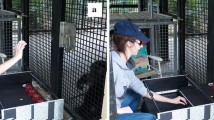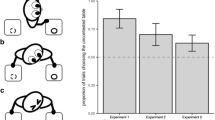Abstract
This study investigated the ability of chimpanzees, gorillas, orangutans, and bonobos to make inferences by exclusion using the procedure pioneered by Premack and Premack (Cognition 50:347–362, 1994) with chimpanzees. Thirty apes were presented with two different food items (banana vs. grape) on a platform and covered with identical containers. One of the items was removed from the container and placed between the two containers so that subjects could see it. After discarding this item, subjects could select between the two containers. In Experiment 1, apes preferentially selected the container that held the item that the experimenter had not discarded, especially if subjects saw the experimenter remove the item from the container (but without seeing the container empty). Experiment 3 in which the food was removed from one of the containers behind a barrier confirmed these results. In contrast, subjects performed at chance levels when a stimulus (colored plastic chip: Exp. 1; food item: Exp. 2 and Exp. 3) designated the item that had been removed. These results indicated that apes made inferences, not just learned to use a discriminative cue to avoid the empty container. Apes perceived and treated the item discarded by the experimenter as if it were the very one that had been hidden under the container. Results suggested a positive relationship between age and inferential ability independent of memory ability but no species differences.




Similar content being viewed by others
References
Barth J, Call J (2006) Tracking the displacement of objects: a series of tasks with great apes and young children. J Exp Psychol: Anim Behav Proc (in press)
Bräuer J, Call J, Tomasello M (2005) All great ape species follow gaze to distant locations and around barriers. J Comp Psychol 119:145–154
Bräuer J, Kaminski J, Riedel J, Call J, Tomasello (2006) Making inferences about the location of hidden food: social dog–causal ape. J Comp Psychol 120:38–47
Call J (2001) Object permanence in orangutans (Pongo pygmaeus), chimpanzees (Pan troglodytes), and children (Homo sapiens). J Comp Psychol 115:159–171
Call J (2004) Inferences about the location of food in the Great Apes (Pan paniscus, Pan troglodytes, Gorilla gorilla, and Pongo pygmaeus). J Comp Psychol 118:232–241
Collier-Baker E, Davis JM, Suddendorf T (2004) Do dogs (Canis familiaris) understand invisible displacement? J Comp Psychol 118:421–433
Collier-Baker E, Davis JM, Nielsen M, Suddendorf T (2006) Do chimpanzees (Pan troglodytes) understand single invisible displacement? Anim Cogn 9:55–61
de Blois ST, Novak MA, Bond M (1999) Can memory requirements account for species' differences in invisible displacement tasks? J Exp Psychol: Anim Behav Proc 25:168–176
Doré FY, Dumas C (1987) Psychology of animal cognition: Piagetian studies. Psychol Bull 102:219–233
Doré FY, Fiset S, Goulet S, Dumas MC, Gagnon S (1996) Search behavior in cats and dogs: interspectific differences in working memory and spatial cognition. Anim Learn Behav 24:142–149
Hashiya K, Kojima S (2001) Hearing and auditory–visual intermodal recognition in the chimpanzee. In: Matsuzawa T (ed) Primate origins of human cognition and behavior. Springer, Berlin Heidelberg New York, pp 155–189
Herman LM, Richards DG, Wolz JP (1984) Comprehension of sentences by bottlenosed dolphins. Cognition 16:129–219
Holm S (1979) A simple sequentially rejective multiple test procedure. Scand J Stat 6:65–70
Kaminski J, Call J, Fischer M (2004) Word learning in a domestic dog: evidence for “fast mapping”. Science 304:1682–1683
Mendes N, Huber L (2004) Object permanence in common marmosets (Callithrix jacchus). J Comp Psychol 118:103–112
Nissen HW, Blum JS, Blum RA (1948) Analysis of matching behavior in chimpanzees. J Comp Physiol Psychol 41:62–74
Pepperberg IM, Funk MS (1990) Object permanence in four species of psittacine birds: an African grey parrot (Psittacus erithacus), an Illiger mimi macaw (Ara maracana), a parakeet (Melopsittacus undulatus), and a cockatiel (Nymphicus hollandicus). Anim Learn Behav 18:97–108
Povinelli DJ, Rulf AB, Landau KR, Bierschwale DT (1993) Self-recognition in chimpanzees (Pan troglodytes): distribution, ontogeny, and patterns of emergence. J Comp Psychol 107:347–372
Premack D (1995) Cause/induced motion: intention/spontaneous motion. In: Changeux JP, Chavaillon J (eds) Origins of the human brain. Oxford University Press, Oxford, pp 286–308
Premack D, Premack AJ (1994) Levels of causal understanding in chimpanzees and children. Cognition 50:347–362
Santos LR, Sulkowski GM, Spaepen GM, Hauser MD (2002) Object individuation using property/kind information in rhesus macaques (Macaca mulatta). Cognition 83:241–264
Schusterman RJ, Krieger K (1984) California sea lions are capable of semantic comprehension. Psychol Rec 34:3–23
Schusterman RJ, Gisiner R, Grimm BK, Hanggi EB (1993) Behavior control by exclusion and attempts at establishing semanticity in marine mammals using match-to-sample paradigms. In: Roitblat HL, Herman LM, Nachtigall PE (eds) Language and communication: comparative perspectives. Lawrence Earlbaum Associates, Hillsdale, NJ, pp 249–274
Spinozzi G (1993) Development of spontaneous classificatory behavior in chimpanzees (Pan troglodytes). J Comp Psychol 107:193–200
Tomasello M, Call J (1997) Primate cognition. Oxford University Press, New York
Tomonaga M (1993) Tests for control by exclusion and negative stimulus relations of arbitrary matching to sample in a “symmetry-emergent” chimpanzee. J Exp Anal Behav 59:215–229
Van Der Walle GA, Carey S, Prevor M (2000) Bases for object individuation in infancy: evidence from manual search. J Cogn Dev 1:249–280
Watanabe S, Huber L (2006) Animal logics: decisions in the absence of human language. Anim Cogn 9. DOI 10.1007/s10071-006-0043-6
Xu F, Carey S (1996) Infants’ metaphysics: the case of numerical identity. Cogn Psychol 30:111–153
Author information
Authors and Affiliations
Corresponding author
Additional information
This contribution is part of the special issue “Animal Logics” (Watanabe and Huber 2006).
Rights and permissions
About this article
Cite this article
Call, J. Inferences by exclusion in the great apes: the effect of age and species. Anim Cogn 9, 393–403 (2006). https://doi.org/10.1007/s10071-006-0037-4
Received:
Revised:
Accepted:
Published:
Issue Date:
DOI: https://doi.org/10.1007/s10071-006-0037-4




